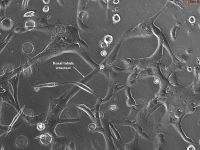Atomic Force Microscopy of -Amyloid: Static and Dynamic Studies of Nanostructure and Its Formation
互联网
607
Ordered aggregation of the β-amyloid (Aβ) peptide in the brain as plaques consisting of fibrils is an important characteristic of Alzheimer’s disease (AD), a late onset neurodegenerative disease (1 ). Aβ derives from the endoproteolysis of the amyloid precursor protein (APP), which is a transmembrane protein containing 677–770 amino acids (2 –9 ). The two most common forms of Aβ are the 40 and 42 residues long fragments respectively referred to as Aβ(40) and Aβ(42) (sequence shown in Fig. 1 ; ref. 10 ). The insoluble aggregated form of Aβ, which deposits in the extra cellular space in the brain and on the walls of cerebral blood vessels (6 ), exhibits an enhanced β-sheet conformation as opposed to the partially α-helical soluble form found in body fluids (11 ,12 ). Despite the lack of the definitive establishment of the causative role of Aβ in AD, evidence points to its aggregation and deposition in the pathogenesis of AD.


Fig. 1. The sequence of Aβ peptide (10 ).








